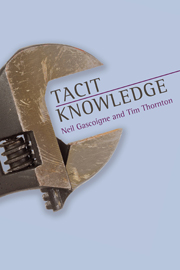4 - Being in the background
Summary
INTRODUCTION
In Chapter 1 we introduced three thinkers whose accounts of human nature and knowing have a bearing on our understanding of tacit knowledge. Having dealt at length with the debate that has arisen around Ryle's distinction between knowing that and knowing how, we turn now to considerations that give succour to the idea that in so far as tacit knowledge is associated with the latter it characterizes a distinct mode of being of creatures like ourselves. The key idea was introduced in §”Regress redux” in relation to Heidegger. It is that the “familiarity with the world” that is our “understanding of being” forms what Hubert Dreyfus characterizes as the non-intentional “background” (BB) to both the fundamental intentionality (FI) of the know-how that comprises our ongoing coping practices, and the representational intentionality (RI) of the states characterized by having disengaged reflectively from our practices and associated with the knowledge-that of what is present-at-hand.
At the time we noted that Heidegger's distinction between the “ur” know-how of the background and the more intramundane know-how of our practices was not something we wished to uphold. It is also, of course, a source of embarrassment to phenomenologists of a Dreyfusean persuasion. Like Polanyi, for example, they want to argue that the knowledge-how that exhibits the “naturalness” of our natures should be understood to denote a mode of being shared with other animals (and consequently illuminated by the sort of experimental finding Polanyi was so fond of).
- Type
- Chapter
- Information
- Tacit Knowledge , pp. 107 - 132Publisher: Acumen PublishingPrint publication year: 2013



